coastal landforms
- Created by: sophie annn
- Created on: 10-03-20 19:49
Landforms created by erosion
The coastline is constantly eroding. There are four key types of erosion:
- Abrasion - waves transport material which hit the cliff and gradually wear it away.
- Hydraulic action - as waves approach the coast they trap air and force it into gaps in the cliff. Eventually this weakens the rock.
- Attrition - waves cause the rocks to crash against each other, breaking them down into smaller and rounder pieces.
- Corrosion (also known as solution) - salts and acids in seawater dissolve the rock gradually over thousands of years.
In addition, changes in landforms can be a result of wind erosion, weathering and sub-aerial processes such as mass movement.
Headlands and bays
Headlands are usually formed of more resistant rock types than bays.
If there are different bands of rock along a coastline, the weaker or softer rock, such as clay, is eroded fastest. This leaves more resistant rock types, such as granite, sticking out.
Caves, arches, stacks and stumps
Headlands can be vulnerable to erosion because they stand out from the rest of the coast. Over time, other features may develop on a headland:
Waves cause weaknesses to form cracks at the base of the headland
Over time the cracks become larger to form a cave
The cave gets bigger and cracks appear above the cave to the top of the headland
The arch grows larger and eventually collapses leaving a stack separated from the mainland
The stack erodes and becomes a stump
Cliff erosion and wave-cut platforms
Stages in cliff retreat
- Waves attack the bottom of the cliff, particularly during storms and at high tide.
- Eventually a wave-cut notch is formed.
- At the same time weathering attacks and weakens the top of the cliff.
- The weakened cliff is left unsupported and eventually collapses.
- Once the sea has removed the fallen rocks it can start the process again.
- The cliff will move back and leave a rocky platform at the base called a wave-cut platform.
Landforms created by deposition
Deposition occurs when the sea has less energy, eg in sheltered bays. Material that has been eroded from the coast is transported by the sea and later put down.
Longshore drift is a process of transportation that shifts eroded material along the coastline.
- Waves approach the coast at an angle.
- Swash carries sediment up the beach at an angle.
- Backwash carries sediment down the beach with gravity – at right angles to the beach.
- This creates a zig-zag movement of sediment along the beach.
Spits
Spits are also caused by deposition - they are features that are formed by the process of longshore drift.
A spit is an extended stretch of beach material that only joins the mainland at one end. They start to form where there is a change in the direction of the coastline.
An example of a spit is Spurn Head, north of the Humber Estuary in the north east of England. It is fed by the movement of material from the erosion of the Holderness Coast to the north. This is an area of weak boulder clay.
sm and b
Salt marsh
Salt marshes may be formed behind a spit. The zone behind a spit becomes a sheltered area. Water movement slows down and so more material is deposited. Deposition may form a salt marsh.
Beaches
Beaches are formed from deposits of sediment.
Types of erosion
The energy in a river causes erosion. The bed and banks can be eroded making it wider, deeper and longer.
Headward erosion makes a river longer. This erosion happens near its source. Surface run-off and throughflow cause erosion at the point where the water enters the valley head.
Vertical erosion makes a river channel deeper. This happens more in the upper stages of a river (the V of vertical erosion should help you remember the V-shaped valleys that are created in the upper stages).
Lateral erosion makes a river wider. This occurs mostly in the middle and lower stages of a river.
There are four main processes of erosion that occur in rivers. These are:
- hydraulic action;
- abrasion / corrasion;
- attrition; and
- corrosion.
Transportation
Transportation of material in a river begins when friction is overcome. Material that has been loosened by erosion may be then transported along the river. There are four main processes of transportation. These are:
- suspension / suspended load;
- solution / solution load;
- saltation; and
- traction.
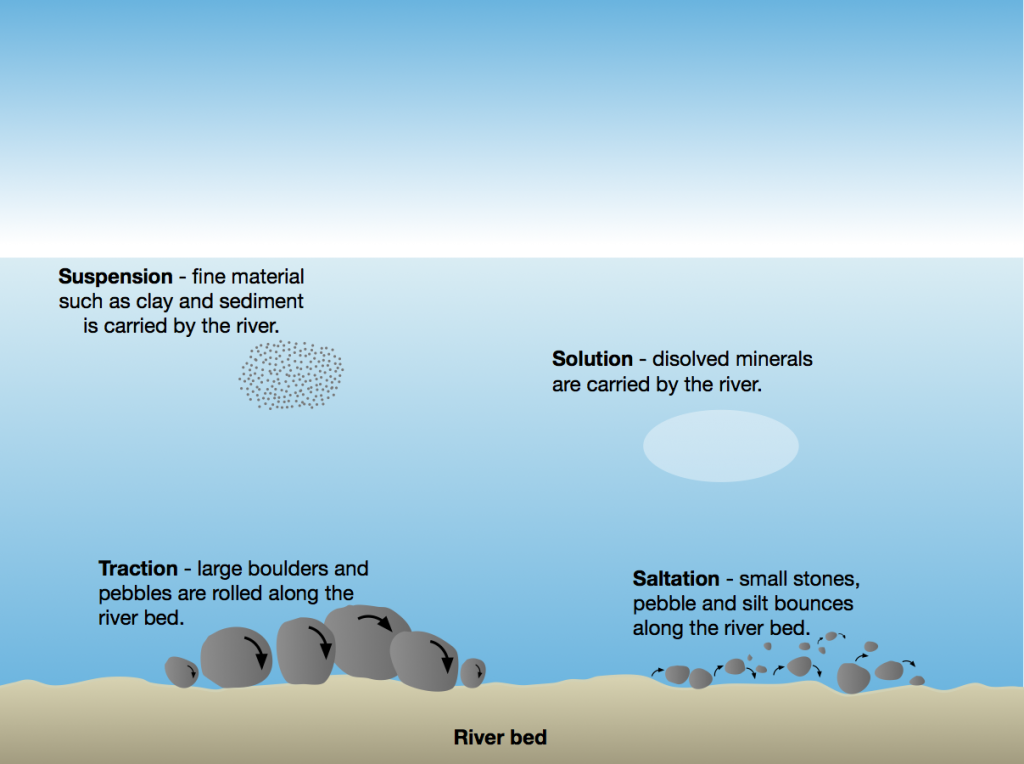
Deposition
Deposition is the process of the eroded material being dropped. This happens when a river loses energy. A river can lose its energy when rainfall reduces, evaporation increases, friction close to river banks and shallow areas which leads to the speed of the river reducing and therefore the energy reduces, when a river has to slow down it reduces its speed (and ability to transport material) and when a river meets the sea.
Hard engineering
ea walls
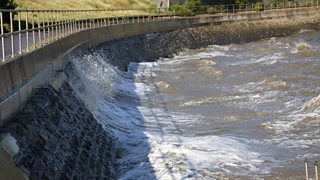 A sea wall
A sea wall
Concrete walls that are placed at the foot of a cliff to prevent erosion. They are curved to reflect the energy back into the sea.
Advantages
- Effective at protecting the base of the cliff.
- Sea walls usually have promenades so people can walk along them.
Disadvantages
- Waves are still powerful and can break down and erode the sea wall.
- Expensive - approximately £2,000 per metre.
Rock armour
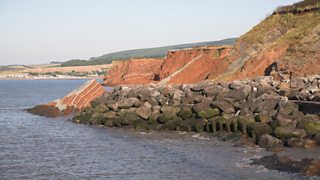 Rock armour on a beach
Rock armour on a beach
Large boulders placed at the foot of a cliff. They break the waves and absorb their energy.
Advantages
- Cheaper than a sea wall and easy to maintain.
- Can be used for fishing.
Disadvantages
- They look different to the local geology, as the rock has been imported from other areas.
- The rocks are expensive to transport.
Gabions
 Gabions
Gabions
Rocks are held in mesh cages and placed in areas affected by erosion.
Advantages
- Cheap - approximately £100 per metre.
- Absorbs wave energy.
Disadvantages
- Not very strong.
- Looks unnatural.
Soft engineering
Beach nourishment
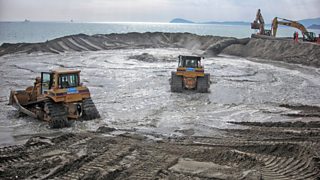 Bulldozers moving sand during beach nourishment
Bulldozers moving sand during beach nourishment
Sand is pumped onto an existing beach to build it up.
Advantages
- Blends in with the existing beach.
- Larger beaches appeal to tourists.
Disadvantages
- Needs to be constantly replaced.
- The sand has to be brought in from elsewhere.
Reprofiling
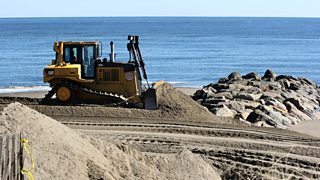 A bulldozer moves sand up the beach
A bulldozer moves sand up the beach
The sediment is redistributed from the lower part of the beach to the upper part of the beach.
Advantages
- Cheap and simple.
- Reduces the energy of the waves.
Disadvantages
- Only works when wave energy is low.
- Needs to be repeated continuously.
se
Managed retreat
Managed retreat is the controlled flooding of low-lying coastal areas. If an area is at high risk of erosion, managed retreat could be an option. It usually occurs where the land is of low value, for example farm land.
 Abbotts Hall Farm salt marshes - an example of managed retreat
Abbotts Hall Farm salt marshes - an example of managed retreat
Advantages
- This is a cheap option compared to paying for sea defences.
- Creates a salt marsh which can provide habitats for wildlife and a natural defence against erosion and flooding.
- Salt marshes are diverse ecosystems supporting many species.
Disadvantages
- Land is lost as it is reclaimed by the sea.
- Landowners need to be compensated - this can cost between £5,000 - £10,000 per hectare.
The Pros And Cons Of An Ageing Population
The main disadvantages of an ageing population include increase in pension and health-care costs. An increase in the proportion of elderly in the population opens questions as to how best to finance them after retirement. An increasing number of elderly persons means more pension requirements, resulting in an increase in the cost to the Government and, therefore, taxpayers. If most of these elders were pension contributors, then the additional cost to the Government would be less. However, the fewer the pension contributors in the country, the more the cost to the citizens to facilitate them after retirement. Only 22 per cent of the total number of people in Jamaica's labour force made pension contributions in 2012, the remaining 78 per cent must be saving to compensate their financial needs if and when they reach retirement age.
Older people are more prone to illnesses and ailments; as such, an increasing number of sick persons will put pressure on health-care facilities, which might not be able to cope with the demand. Diabetes, hypertension and cancer increase in likelihood with age.
What Are The Advantages Of An Ageing Population?
An increase in the proportion of elderly persons in the population leads to a growing pool of volunteers in the economy. This has been identified as a global advantage where the elderly contribute free labour to community and government projects after retirement. These elders are more comfortable financially and find pleasure in giving back to their communities and countries. However, the numbers might be less in developing countries like Jamaica, where some elders are still competing with young people for legitimate paid jobs due to insufficient pension to cover their expenses. Some simply cannot retire or they risk dying of hunger due to no source of income.
Older people have lived longer, hence are more experienced than younger people. An ageing population can be advantageous in this case, using their experience to help uphold morals and values in a country. They also are more familiar with the culture and way of life of a group of people than their younger counterpart, and therefore, are necessary to help instil tradition and way of life conducive to longevity.
An ageing population is associated with fewer children. Another advantage highlighted as a result, is cost savings associated with having to cater to fewer children and young people in the economy. This would result in lower public education cost, lower health-care cost and other social programmes provided for children by the Government.
ageing population
United Kingdom/Population 66.44 million (2018) Most people migrate for economic reasons. People think about emigrating from places that have few job opportunities, and they immigrate to places where jobs seem to be available. Because of economic restructuring, job prospects often vary from one country to another and within regions of the same country.Migration occurs for many reasons. The overwhelming majority of people migrate internationally for reasons related to work, family and study – involving migration processes that largely occur without fundamentally challenging either migrants or the countries they enter
why the population of the UK has grown
-
In mid-2018, the population of the UK reached an estimated 66.4 million.
-
The UK population’s growth rate in mid-2017 and mid-2018, at 0.6%, was slower than any year since mid-2004.
-
Long-term international migration to and from the UK has remained broadly stable since the end of 2016 and has also continued to be the main driver of the UK’s population growth.
-
In 50 years’ time, there is projected to be an additional 8.2 million people aged 65 years and over in the UK – a population roughly the size of present-day London.
-
After decades of improvement to life expectancy, the latest figures show a slowdown in improvement – life expectancy at birth remained at 79.2 years for males and 82.9 years for females in 2015 to 2017.
africa location
- North Africa lies north of the Sahara and runs along the Mediterranean coast.
- Northwest Africa
- West Africa is the portion roughly west of 10° east longitude, excluding Northern Africa and the Maghreb. West Africa contains large portions of the Sahara Desert and the Adamawa Mountains.
- Northeast Africa
- East Africa stretches from the Red Sea and the Horn of Africa to Mozambique, including Madagascar
- Southeast Africa
- Central Africa is the large mass at the center of Africa which either does not fall squarely into any other region or only partially does so.
- Southern Africa consists of the portion generally south of -10° latitude and the great rainforests of Congo.
the different areas of Africa
Africa has eight major physical regions: the Sahara, the Sahel, the Ethiopian Highlands, the savanna, the Swahili Coast, the rain forest, the African Great Lakes, and Southern Africa.
Comments
No comments have yet been made